Archive for Summer
Sustainable Landscaping Practices for August: Thriving in California’s Dry Heat
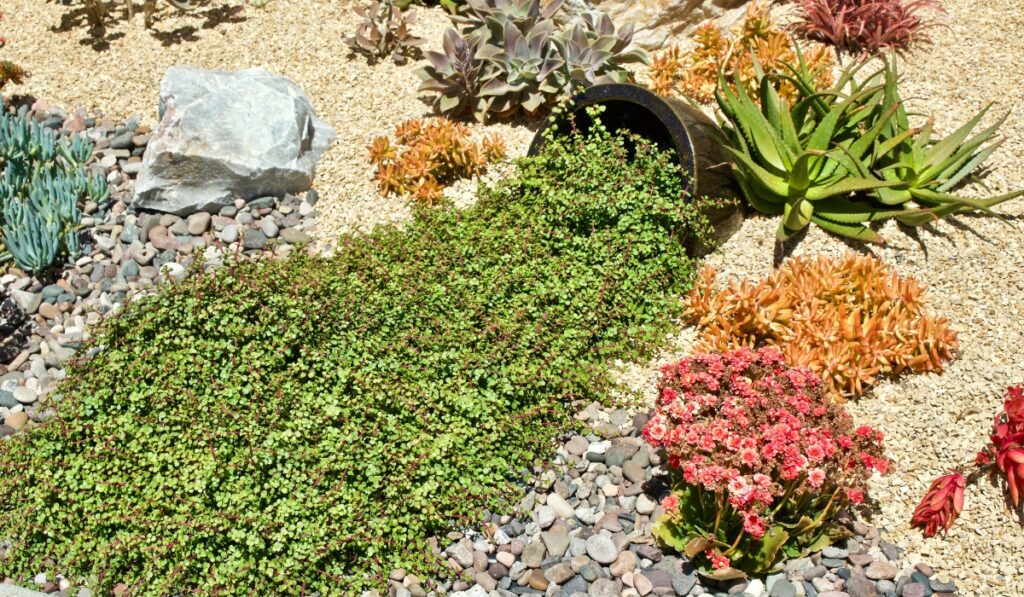
As Californians, we’re all too familiar with the challenges of August’s scorching temperatures and persistent drought conditions. While our landscapes may be feeling the heat, there are plenty of sustainable practices we can adopt to not only keep our gardens thriving but also nurture the environment. At DK Landscaping, we believe in creating beautiful landscapes that are in harmony with nature, and August is the perfect time to implement eco-friendly choices.
The Importance of Water Conservation
Water is a precious resource, especially during the peak of summer. Traditional landscaping practices often rely heavily on irrigation, putting a strain on our water supply. By embracing sustainable practices, we can significantly reduce our water consumption and help protect this vital resource.
Key Sustainable Landscaping Practices for August
Let’s delve into some essential eco-friendly choices you can make in your landscape this August:
1. Efficient Irrigation:
- Upgrade your irrigation system: Consider switching to drip irrigation or soaker hoses, which deliver water directly to the roots, minimizing evaporation and runoff.
- Water deeply and less frequently: This encourages deeper root growth and reduces water waste.
- Water in the early morning or late evening: Avoid watering during the hottest part of the day to prevent evaporation.
- Monitor soil moisture: Use a moisture meter to check soil moisture levels before watering.
- Adjust your irrigation schedule: As temperatures cool down in late August, gradually reduce watering frequency.
2. Mulching:
- Apply a thick layer of mulch: Mulch helps retain soil moisture, suppress weeds, and regulate soil temperature. Organic mulches like wood chips or shredded leaves also improve soil health as they decompose.
3. Drought-Tolerant Plants:
- Choose native and adapted plants: These plants are naturally suited to California’s climate and require less water.
- Group plants with similar water needs: This allows for more targeted and efficient irrigation.
- Consider replacing lawns with low-water alternatives: Opt for groundcovers, native grasses, or permeable hardscaping.
4. Rainwater Harvesting:
- Install rain barrels or cisterns: Collect rainwater from your roof to use for irrigation later.
- Create rain gardens: These shallow depressions capture and filter rainwater runoff, reducing erosion and providing habitat for wildlife.
5. Composting:
- Start a compost pile: Turn kitchen scraps and yard waste into nutrient-rich compost to improve soil health and reduce the need for synthetic fertilizers.
6. Organic Fertilizers:
- Use organic fertilizers and soil amendments: These products nourish your plants without harming the environment.
7. Reduce or Eliminate Pesticide Use:
- Embrace Integrated Pest Management (IPM): This approach focuses on prevention and natural controls to minimize pesticide use.
- Attract beneficial insects: Plant flowers that attract ladybugs, lacewings, and other insects that prey on pests.
DK Landscaping: Your Partner in Sustainable Landscaping
At DK Landscaping, we are committed to creating sustainable landscapes that are both beautiful and environmentally responsible. We can help you implement these eco-friendly practices and design a garden that thrives in California’s unique climate.
Contact us today to schedule a consultation and let us help you create a sustainable oasis.
Remember, every small step towards sustainability counts. By implementing these practices in your landscape, you can make a positive impact on the environment while enjoying a beautiful and thriving garden.
The Principles of Xeriscaping on Your Property
Living in a hot and dry area or one that does not have much rainfall does not mean that you cannot have the exceptional landscapes typical in places with a lot of rain. Furthermore, you need not waste the average 90 gallons of water watering the plants for a thriving lawn or landscape. There is one option for having a flourishing lawn in an eco-friendly manner, even in dry regions. The solution lies in xeriscaping.
Xeriscaping denotes a landscaping design method based on water conservation. Though often meant for property owners in semi-arid and arid places, the design can also be used in areas with a lot of rain to conserve water. The concept in xeriscaping is conserving water through the correct landscaping principles.
Below are the guiding principles of xeriscaping.

Limited Turf Area and Use a Suitable Grass Variety
Grass is beneficial in landscaping because it controls erosion and water infiltration into the soil. However, a large turf section is one of the biggest causes of wasted water for landscaping. You should try to have grass only in the sections where kids and pets will need it or, in commercial spaces, only in regions that can accommodate many people.
It is best to limit the grass in your landscape to the flat and shaded areas of your property. This minimizes the risk of runoff and evaporation. You should also pick the grass varieties that have deeper roots, since they retain moisture better than those with shallow roots. Some of the best varieties for xeriscaping include Blue Grama, California Oatgrass, Blue Fescue, Bermuda, Buffalo, and St. Augustine.
Improved Soils
Consider using organic soil enhancements like manure, wood chips, peat moss, or grass clippings to improve your landscaping soil. These will support the growth of plants with broad root systems, allow natural aeration, and increase the soil’s water retention capacity.
There are also commercial inorganic soil amendments, but these are more expensive than their organic counterparts. However, they will still benefit your lawn if you, for whichever reason, cannot get organic enhancements. Before any soil improvements, the soil is tested to know its elements that need increasing and the best options for it.
Addition of a Water-retaining Mulch
Mulch will form a protective layer between the air and your plants’ roots, thus encouraging water retention. The best options for this are pine needles and shredded hardwood. Water retention not only improves plant health but will also minimize the evaporation rate and thus reduce the frequency of watering plants. In hot, dry climatic regions, steer clear of rocks and mulch types that radiate or retain heat. These only burn your plants.
Inclusion of a Rain Garden in Runoff Sections
Rain gardens are ideal options for cleaning and capturing groundwater in the low-lying sections of your property. Though dry in most instances, they will hold a generous amount of water after it rains. You can include perennials, flowers, and native shrubs around the rain garden to create a beautiful landscape bed. You can also settle for cisterns, porous paving, and rain barrels to capture runoff that can be recycled to water your landscape.
The Use of Drought-resistant and Native Plants
Drought-resistant and native plant species will often consume less water than exotic species. You can find a broad range of drought-resistant landscaping plants at your local nursery to match your envisioned design. To ensure you get the suitable plant varieties, research the distribution and amount of rainfall in your area beforehand.
Pick plants based on their expected sizes when mature rather than the size in which you buy them. Moreover, pick a few trees to maximize the shade in your landscape for the plants. This shade reduces evaporation, and the trees will act as windbreakers that protect your fragile plants.
An Effective Irrigation Method
Soaker hoses or drip irrigation is the ideal irrigation option in xeriscaping. This comprises a network of pipes with tiny holes that deliver water to the plants’ roots to minimize evaporation and water wastage. Overhead irrigation or using a watering cane leads to less water delivered to your plant roots and wastes a lot of water.
Furthermore, consider watering your plants in the morning because the water will evaporate slowly in cool conditions at this time. Watering plants in the morning also allows them to dry as the day progresses. This reduces the risk of your plants contracting fungal diseases that usually affect humid or constantly wet plants.
If you want to start conserving water in your landscaping design, do not assume that this is as easy as sticking to the xeriscaping principles above. There are different elements like making the right choice of mulch in relation to your soil, climate, and plants. To save time and guarantee the best results, hire skilled landscapers from DKlandscaping to handle your xeriscaping.
The Right Fertilizer and Landscape Maintenance for Your Unique Property
Every property needs landscape maintenance tailored to its unique idiosyncrasies. Though few know it, the winter fertilizer placed on your lawn makes a major difference in its look and quality. The degree of proper landscaping maintenance applied to your property matters a great deal. Instead of attempting to figure out all the nuances of lawn and landscaping management on your own, let our team do the work for you.
The Optimal Fertilizer for Your Lawn

There is a common misconception that any old fertilizer will suffice for a lawn. This is precisely why we closely evaluate local lawns to determine which fertilizer is best. Though you won’t notice results right away after we apply our specialized winter fertilizer, it will provide your lawn with all sorts of benefits.
Our special fertilizer for wintertime treatments bolsters grass so it doesn’t need nearly as much water. Our fertilizer stimulates root development and also boosts resistance to disease as well as traffic. Place your trust in our team to fertilizer your lawn and provide landscape maintenance and you will rest easy knowing the best in the business are hard at work on your property. We have provided service throughout Sonoma County for more than a decade. We have all the expertise, manpower and equipment necessary to manage your landscape during the challenging winter and also year-round. Let our team do all of the work and you will be liberated to sit back, relax and enjoy the beauty of your property.
We Sweat the Small Stuff so You Don’t Have To
Our team provides a lawn fertilization management program so you don’t have to lift a finger to ensure your lawn is properly fertilized and maintained throughout the entirety of the year. This is your opportunity to kick back and relax while our team handles all the aspects of landscape maintenance on your behalf. We add lawn fertilizer once every two months. Our team applies truly elite fertilizers optimal for the specific season. In fact, we even add slow-release fertilizer in the summer and spring months to bring out the best in your lawn.
The Best Lawn Maintenance Management Program in Town
While many other landscape maintenance companies do the bare minimum, we take the opposite approach. We have gone to great lengths to ensure our standard maintenance program covers all aspects of lawn maintenance management. There are absolutely no hidden fees when you lean on our team for landscape maintenance. We do all of the work so you can enjoy the beauty of your landscaping. Our services extend to both local homes and local businesses. Take advantage of our maintenance management program and you will be treated to mowing, lawn edging, blow yard services, leaf/litter cleanup and our lawn fertilization management program as detailed above.
We really do go to the extent of adding fertilizers to your lawn that are optimal for each unique season. In fact, our team even controls and manages weeds on your lawn so it looks its best throughout the entirety of the year. Whether you are looking for your plants to be trimmed/pruned, herbicide to bet added to weeds, fresh batteries to be added to your timers or your irrigation to be checked by QWEL-certified personnel, our team gets the job done to perfection on the first try without exception.
Reach out to us Today to Schedule Service
If you own a home, a business or any other property, contact our team today to schedule landscape maintenance and additional services. You can reach our landscaping experts by dialing (707) 280-3632 or by emailing Kathyx159@aol.com.
Landscaper Rohnert Park: Maintain a Beautiful Yard
If you have ever walked into any building or garden landscape in Rohnert Park California and you felt warm and welcome, chances are that the yard was cleaned, creatively designed and well maintained by a professional landscaper in Rohnert Park.
A well looked after yard is a sight to behold and creates a serene atmosphere that is second to none. However, this does not happen automatically. For you to enjoy a beautiful, lush and green yard, you will need to make a few investments. These include time and patience. You also have to get the right information that will guide you on the best way to go about it.
Tips From a Professional Landscaper in Rohnert Park
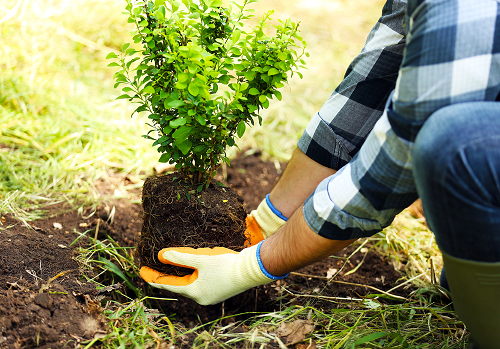
Fortunately, if you are looking for a landscaper in Rohnert Park, you don’t have to break a sweat. In this article you will learn how to transform your yard from a boring one into something that you can proudly look forward to come home to.
Here are different ways to ensure that your yard is elegant regardless of the season.
- Start right
Just like in every other aspect, the foundation will more often than not determine the outcome. In this case, since you will be dealing with soil, it important to have it right. In most cases the soil acidity level, commonly known as pH is high, thus hindering proper growth of grass. It is advisable to take some soil samples for testing and advice on the best way to fix any problems that may present.
It is also important at this stage to get the right information on what is the best type of vegetation to consider. There is no one size fits all vegetation. While some may be suitable for a certain location, they may be unsuitable for you.
- Access unique needs for your yard.
Whenever you have plants be it grass, trees or flowers, it is important to understand that they all have unique needs. Grass in the shady areas, for example, will need less water and fertilizer as the level of evaporation is low, and they grow less. And the opposite it also true. Having this in mind will make is easy for you when undertaking your daily yard maintenance.
- Create a monthly routine based on seasons
Different seasons present different challenges for maintaining lawns. If you have been keen to look around, you may have noticed that most people take care of their lawns during summer and barely touch them after. Unfortunately, due to the negligence, these lawns do not thrive well. To ensure that your backyard yard remains attractive throughout the year, you need to carry out specific tasks based on the season.
- Spring time is the best time to strengthen your grass in readiness for the expected warm days. It is during this season that you should rake to remove any twigs and leaves, mow regularly, apply fertilizers when the soil is moist and also sow new grass to fill in any soil patches. Remember that proper covering discourages weed growth.
- During summer, the activities are centered on maintenance activities. You will engage on more watering, mowing and applying fertilizer.
- In autumn, leaves may suffocate grass. To avoid this, there is need to aerate the yard, mow the lawns and apply some fertilizer.
- Winter season has the least activities in yard maintenance. You only need to remove any leaves that may have fallen over and avoid stepping on the grass. However it provides the best season for planting a new lawn.
A lawn make-over is just what you need if your lawn isn’t in great shape. For more tips on yard maintenance, repair, irrigation and water saving landscape design, feel free to contact us.
Ways To Master Your Summer Lawn Care
Here are the Top 5 tips For Summer Lawn Care that can help you to achieve the best lawn.
- Starting Over – Cleaning Up –
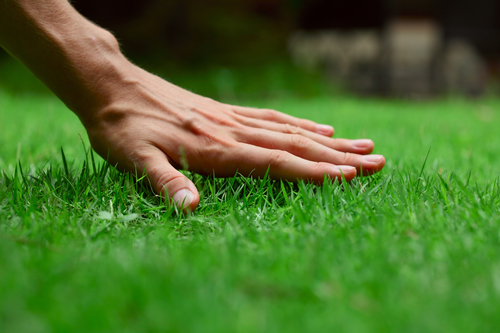
The first thing you should start by doing is walking over your lawn and gather branches, twigs, leaves and any other debris that has accumulated and dispose of. (Or it can be thrown in the compost bin to later be used as mulch)
Cleaning up your lawn area should also include raking up any matted areas of the lawn which can encourage snow mold. Not only does this help to prevent any disease or insect infestation but at the same time it promotes better air flow throughout the turf and allows new grass blades to grow without difficulty.
- Protect Your Interest – Weed Control –
Weeds can definitely be a gardener’s worst nightmare and no matter how you try to get rid of them they keep coming back. Though you may not be able to stop them completely there are things you can do to keep them at bay. Weed control.
As part of your lawn care, it is very important to carry out weed control – applying an effective weed killer whether it be organic or inorganic before temperatures hit 55-60 degrees. If you wait until temperatures reach this point, conducting weed control will be pointless as weed seeds would have already begun to germinate.
- Kick Start Growth – Fertilizing –
Winter really signifies a dormant period for gardens and landscapes as your lawn and other areas tend to go into a slumber, however, fertilizing your lawn and other garden areas in the spring gives it a much-needed jumpstart.
This provides an intensified nutrient build up that will give your lawn and other areas the strength they require to withstand the heat and drought that follow in the summer months.
- Let It Breathe – Core Aeration
Just like weed control, it is important to core aerate lawns in the spring as part of your lawn care, before soil temperatures reach 55-60 degrees since this encourages aggressive weeds to populate void spaces in a lawn. Allowing water and air to reach root zones easily, core aeration is great for lawns and helps gardeners to quickly achieve new growth when they apply this useful tip.
- Repair And Rejuvenate Lawns – Re-Seeding Turf
Nine times out of ten winter will wreck havoc on your lawn and come spring the damage is done. Now what? Well, as long as the weather permits it how about doing some re-seeding?
This is a great technique gardeners can use to restore damaged areas of their lawns, however, it may be a bit tricky if you’re applying a pre-emergent weed control so it must be carefully done.
You see, pre-emergent weed control isn’t selective, meaning it will prevent ANY seed from germinating including those used to reseed your turf.
Usually, it’s recommended to hold off weed control to the latest point possible an to perform the turf repairs needed as early as possible so that the seeds have enough time to germinate and become established before weed killer is applied. If this is not possible, don’t skip your weed control instead wait until fall to perform any turf repairs necessary.
Bonus Tips For Lawn Care
- Mow Turf On A High Setting – You should adjust your mower to cut your lawn grass at the highest possible setting. Most turf types usually thrive better when blade heights are about 3 to 4 inches tall.
- When mowing Zoysia grass and Centipede grass, use the lowest setting. For Bermuda grass and creeping bentgrass, it’s best to remove only a third of the total grass blade length at a time.
- Applying mulch – Mulches help to provide essential nutrients and help with weed prevention and soil stability all season long be sure to apply some where necessary.
Contact the experts here at DK Landscaping – our expert team is on call to come in and assist you with any lawn care or gardening task that you have.
Give us a call at (707) 280-3632 or you can visit our website at dklandscaping.com for more information or book your appointment.
How to Transplant Shrubs in Summer
The best times of year to transplant trees and shrubs are spring and fall; however, certain situations may make it necessary to move your plants outside of those seasons. For example, you may want to take your shrubs with you if you are moving or you may have to move the plant because of the weather.

If you find it necessary to move a plant during the warmest part of the year, you will need to take certain steps to ensure its health. Here are some tips on how to move shrubs in the summer without harming them:
- Choose the Right Location
Transplantation represents a dramatic change and a plant will have to adapt to its new environment slowly in order to survive. This means that you will have to keep factors like sunlight, soil drainage and soil pH in mind when choosing a new location. - Dig an Appropriate Hole
You will need to dig a hole that is approximately twice as large as the shrub’s root system. The additional space allows the roots to grow into the new site comfortably. - Carefully Remove the Shrub
Work carefully to avoid damaging the root system when uprooting shrubs. You will want to take as much of it as you can. You will also want to move some of the soil from the old location to the new one. You can place larger shrubs on a tarp and drag them to the new location along with some of the soil. - Add Adequate Water to the New Hole
You will want to wet the hole thoroughly before placing the shrub into it but avoid oversaturating it as this can cause the shrub’s roots to rot. - Place Shrub in the New Hole
Along with the shrub, place some of the soil from the old location into the hole as well as some potting soil. Pat the soil down around the base to ensure that the shrub stays upright. You can add watering stakes to the ground so that the shrub can water at root level but this is not essential. Be careful to avoid damage to the roots when installing the watering stakes.
The quality of your landscaping plays a major role in your ability to enjoy your yard and in your property value. If you need help with moving shrubs or with any other aspect of landscape maintenance, contact us today. Our experienced landscaping crews know how to move your shrubs and trees quickly and without damaging them.
Go Native, Save Water: Xeriscape Gardening
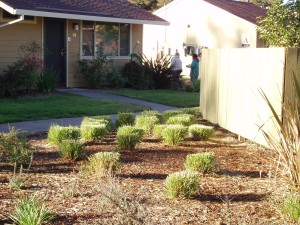 The information age has brought with it a flood a varying techniques in the fields of landscaping, gardening and ecological design. In keeping with the sustainable nature of the best of them, xeriscape gardening is defined by its optimal use of a minimal amount of water. This approach to gardening has been developed in the arid regions in the world, chiefly in the American mid-west, as a natural response to the climate. Xeriscape is most effective when the need for supplemental irrigation is eliminated and the design of the garden promotes symbiotic relationships that provide benefits. Environmental conservancy is xeriscape gardening’s top priority, but aesthetic design has received as much consideration. At its best, xeriscape becomes a melding of both utility and beauty.
The information age has brought with it a flood a varying techniques in the fields of landscaping, gardening and ecological design. In keeping with the sustainable nature of the best of them, xeriscape gardening is defined by its optimal use of a minimal amount of water. This approach to gardening has been developed in the arid regions in the world, chiefly in the American mid-west, as a natural response to the climate. Xeriscape is most effective when the need for supplemental irrigation is eliminated and the design of the garden promotes symbiotic relationships that provide benefits. Environmental conservancy is xeriscape gardening’s top priority, but aesthetic design has received as much consideration. At its best, xeriscape becomes a melding of both utility and beauty.
The Principles of Xeriscape
As conceived by Denver Water, xeriscape gardening’s most revered proponent, these seven guiding principles provide the foundation for all considerations within the field. Each principle holds an entire discipline within itself, which means that there is always more to learn and improve upon in this field.
- Planning and Design are the cornerstones of effective gardening, which requires careful attention to your specific environment.
- Soil Management is about knowing what nutrients your selected plants need and what nutrients are available in the soil. Composting is a great way to reinvigorate malnourished soil.
- Plant Selection is an integral part of xeriscape gardening. Thousands of species exist in arid conditions, each with benefits and beauty to offer.
- Turf Minimalism is crucial because the water needs of most grass lawns makes them impractical for dry climates.
- Diligent Irrigation may be the reason you’re interested in xeriscape gardening to begin with. Water is an invaluable resource and appropriate use of it is essential to environmental conservancy.
- Mulch can be composed of several materials such as leaves, wood chips, pine needles and bark. It is spread over the surface of the soil to help with water retention, fertility, prevention of erosion, and reduction of weed growth.
- Maintenance in the form of weed pulling, mulching, and general upkeep should be combined with constant observation to check if your garden layout is working to its full potential.
The Benefits of Xeriscape
- Reduced Water Consumption is both the key aspect of xeriscape gardening and a great benefit of it. It means using less water and making better use of it. Not only will this save you money, but you will be helping your community and environment as well. Re-appropriating rainwater can help you prevent evaporation and runoff, and your garden’s layout can be optimized for better use of it.
- Less Maintenance is required from a xeriscape garden. Much less fertilizer is used, which helps urban runoff pollution, lawn mowing becomes nigh unnecessary, and simple irrigation systems can handle all of your watering needs.
- Pest Control is an added benefit of a really well thought out garden layout. Certain xeriscape friendly plants ward off insects, while prickly cacti do the same for intrusive mammals. Plant selection also enables you to create a sanctuary for desirable birds and insects.
- Property Values Rise when you drought-proof the terrain around your home. Likewise, the design opportunities available to xeriscape can make for some exquisite gardens.
There are an abundance of tips and tricks available for do-it-yourself xeriscape gardening, but expert consideration reaps the true benefits of the art form. Xeriscape specialists develop an uncanny ability to read an environment and discern its possibilities. With a little help, and dedication to the sustainability principles of xeriscape you could be looking at a lower water and power bill, a productive and efficient garden, and a beautiful area in which to relax.
What’s Bugging You? Five Mosquito-Free Garden Plants
Summertime is the hardest time to control mosquitoes. Whether you are relaxing in your garden or near a pool, nothing is more frustrating than to have a mosquito buzzing in your ear. Spraying chemicals is one general solution most people go for, but it’s not necessarily the most safest option. To naturally prevent mosquitoes from crashing your outdoor festivities, here are some aromatic plants that can be easily grown in pots around your outdoor hangout space, or in a border around your patio.
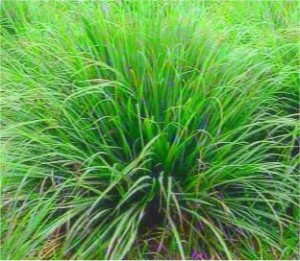
Lemongrass This plant has a fresh lemony fragrance that is appealing to most people, but that mosquitoes absolutely hate. It is the main source of many commercial repellents and repellent lanterns, torches or candles.
Lemongrass can be grown by seed but it’s a lengthy process. If the planting area is a garden or patio, grow this grass behind small shrubs & flowers. Otherwise plant along seating areas or walkways. Better is to grow them in pots which can be brought indoors as the plant is sensitive to cold temperatures.
The quickest way to grow lemongrass is by purchasing a mature bundle of it through any preferred produce spot, Asian store or grocery store.
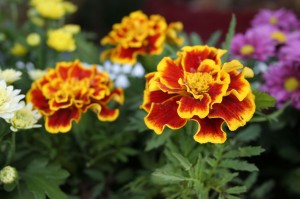
Marigold Commonly grown as ornamental border plants, marigolds are hardy annual plants which have a distinctive smell which mosquitoes, and some gardeners, find particularly offensive. Marigolds contain Pyrethrum, a compound used in many insect repellents.
Potted marigolds can be positioned near entrances to your home and any common mosquito entry points, such as open windows. The smell may deter mosquitoes from going past this barrier. While marigolds can be used as border plants around the patio, we do not advise putting marigolds on the patio table since the bright blooms may attract wasps.
Besides repelling mosquitoes, marigolds repel insects which prey on tomato plants, so you may want to plant a few marigolds in your tomato bed for added protection.
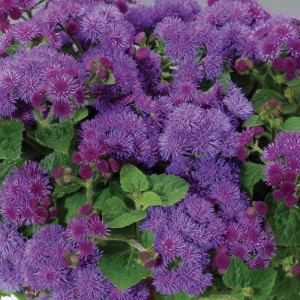
Ageratum Also known as Flossflowers, Ageratum emits a smell which mosquitos find particularly offensive. Ageratum secretes coumarin, which is widely used in commercial mosquito repellents.
Ageratum is a low-lying annual ornamental plant which reaches heights of 8 – 18”, and is easily recognized by its blue flowers, although there are varieties with pink, white and violet blooms.
This plant will thrive in full or partial sun and does not require rich soil. It is often displayed in rock gardens where low-lying plants are favored.
Although the leaves of Ageratum can be crushed to increase the emitted odor, it is not advisable to rub the crushed leaves directly on the skin.

Rosemary This herb is awesome for cooking, but did you know that it’s great for repelling mosquitoes, too?
Rosemary likes a Mediterranean climate, so it thrives in well draining soil and full sunlight. It’s easy to grow and doesn’t require much water. If you live in a warm climate, your rosemary will even survive the winter. If you live in a climate where the winter dips below 30 degrees F, plant your rosemary in pots so that you can bring it indoors during the winter.
Rosemary is technically a shrub and can get quite large, so trim it frequently.
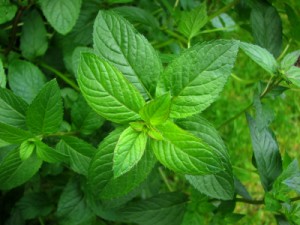
Mint Why it is mosquitoes don’t like the refreshing, delicious scent of mint? It gives off a strong incense-like odor which confuses mosquitoes by masking the smell of its usual hosts.
Mint is a very hardy plant that grows rapidly in the ground or in pots. You can pick mint leaves and rub them on your skin as a mosquito repellent, or just include the plants in your landscape.
Mint leaves can be dried and used to make herbal tea. Its flowers will also attract bees and butterflies to your garden.
As a bonus, mint is also great for cooking and makes refreshing summer cocktails.
As you can see, these are just a sample of a few different plants out there that can help to keep bugs away! For more information and a list of plants that repel pesky mosquitoes contact DK Landscaping (707) 280-3632. So the next time you reach for the chemical bug spray, take a minute and think again, and choose something more natural!
Backyard Beauty On A Budget
Want to build the garden of your dreams, but don’t want to shell out your hard-earned dough? Creating a low-maintenance yard on a budget has its challenges, but there are many ways to meet them. Good planning, a little gardening knowledge, creativity and a willingness to think outside the window-box are all you need to make your yard an enjoyable oasis for family and visitors alike without breaking the bank. DK Landscaping is here to you a less-expensive way to make your yard a better place!
DEFINE YOUR SPACES
Clearly defining the space you need whether it be, dining area, cooking area, shady lounging area, play area can make a great impact on your yard. Doing this can be as inexpensive as repositioning the furniture and accessories you already have. You may also want to build or buy a storage shed to keep kids’ toys out of sight when not in use.
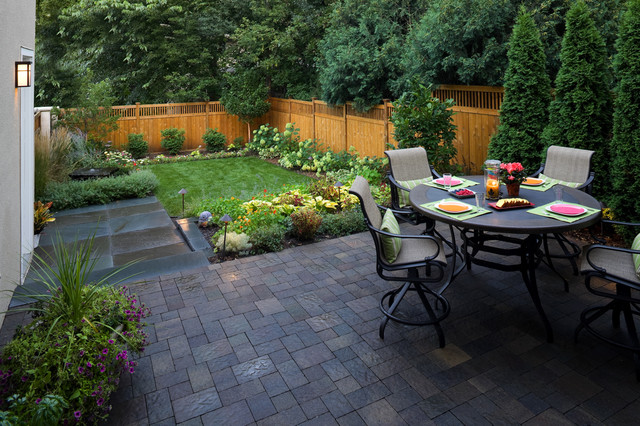
BUY TREES
If you have to spend money on the landscape spend it first on trees. you should always put trees in your landscape before anything else. It is worth a little extra money to get a good landscape tree. There are a lot of trash trees that will send up suckers, leave huge messes on your lawn, require hours of pruning, and die just as your landscape matures. For shade trees, named hybrid maples, oaks, and sycamores are almost always a safe bet. Avoid birches, most elms, poplars, and some ashes which grow fast, but are ultimately short-lived.
THINK VERTICALLY
If your backyard features a large, flat lawn, add some dimension by positioning boulders (available at landscaping supply stores) throughout the space. You might choose to arrange them individually or cluster a few together. Don’t be afraid to cut into the lawn to accommodate them and leave some space around for planting colorful perennials or small shrubs.
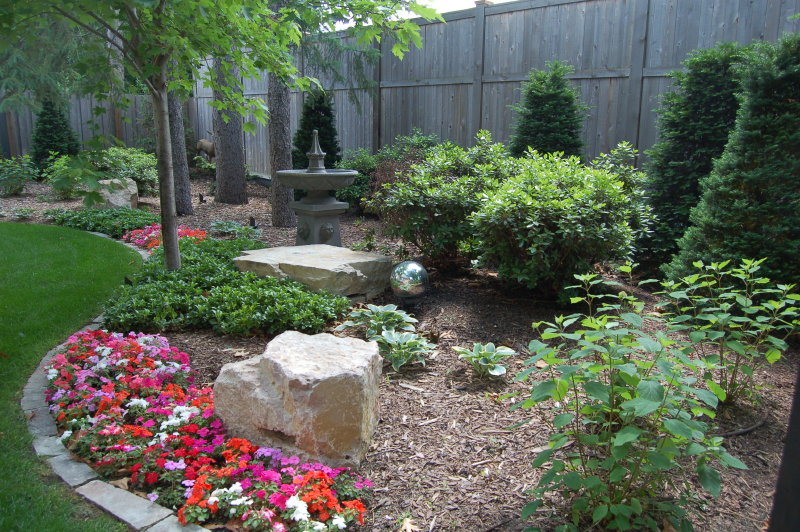
BUY PERENNIALS
As tempting as all those beautiful annuals are on the nursery shelves, think ahead. Every year you will need to replace them, as they die. This is one of the quickest ways to burn through a landscape budget. If you are willing to start annuals from seed (or any other plant for that matter) go for it! Just don’t buy them in a pot (or pony packs, or flats). Perennials on the other hand get bigger and more attractive year after year. A single $2, 4″ potted perennial can be a 8-foot mound of color within three years. The annual will be about the same size as the pot and will have cost three times as much.
TIP: Buy in the fall when perennials are on sale. Trees, shrubs and perennials are the bones of any garden. Unfortunately, they cost an arm and a leg at the beginning of spring and summer. Everyone thinks that you have to plant these at the beginning of the season. The reality is that they can also be planted in the fall when temperatures are cooler. The best part is that trees, shrubs and perennials go on sale at the end of the season, from anywhere between 5o to 75 percent off their regular price.
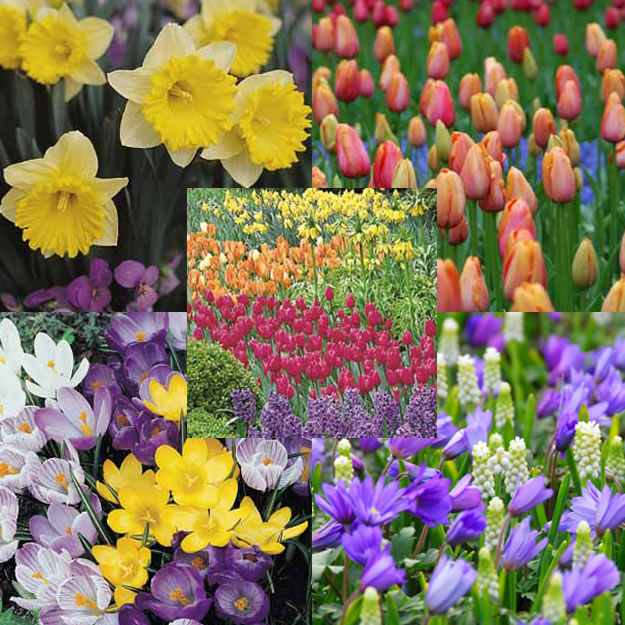
Freecycle and Craigslist
Check out Freecycle and Craigslist to find all manner of garden goodies. Everything from plant divisions to garden tools, pots, containers and even garden furniture often for deals during spring and summer.
You can easily start many plants from seed, get free divisions and cuttings from generous neighbors to help you save cash when planting your own garden. Hardscape goods are really expensive, but you can easily source them from other gardeners who are undergoing remodeling projects. Buying trees, shrubs and perennials at the right time of the year will earn you the biggest savings when landscaping your yard. Use these frugal gardening tips to help you easily landscape your yard into the verdant paradise of your dreams. If you’re interested in learning more about landscaping, consider contacting DK Landscaping for a free consultation (707) 280-3632. Serving the greater Sonoma County areas.






